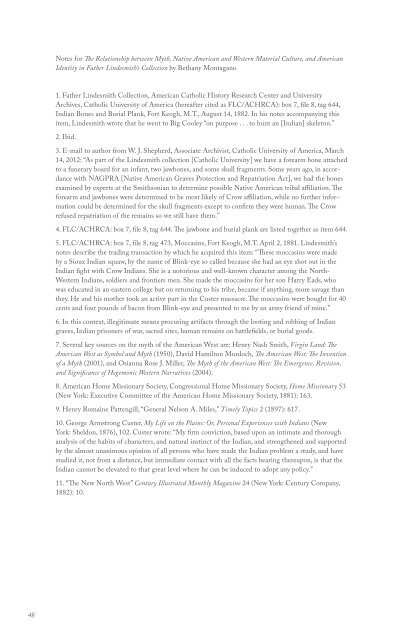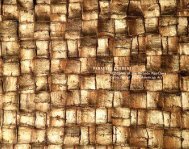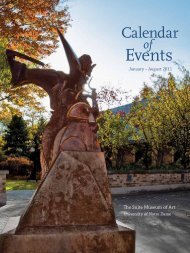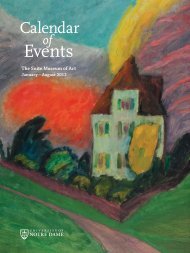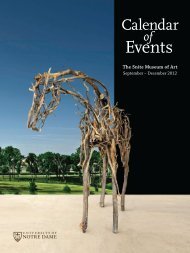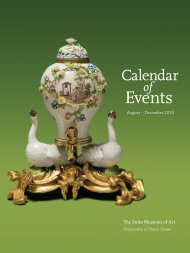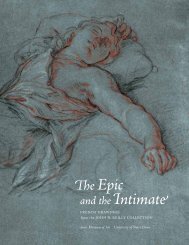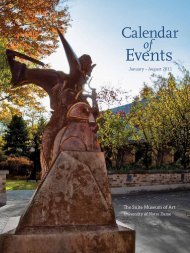HISTORY INTO ART AND ANTHROPOLOGY - Snite Museum of Art ...
HISTORY INTO ART AND ANTHROPOLOGY - Snite Museum of Art ...
HISTORY INTO ART AND ANTHROPOLOGY - Snite Museum of Art ...
You also want an ePaper? Increase the reach of your titles
YUMPU automatically turns print PDFs into web optimized ePapers that Google loves.
Notes for The Relationship between Myth, Native American and Western Material Culture, and American<br />
Identity in Father Lindesmith’s Collection by Bethany Montagano<br />
1. Father Lindesmith Collection, American Catholic History Research Center and University<br />
Archives, Catholic University <strong>of</strong> America (hereafter cited as FLC/ACHRCA): box 7, file 8, tag 644,<br />
Indian Bones and Burial Plank, Fort Keogh, M.T., August 14, 1882. In his notes accompanying this<br />
item, Lindesmith wrote that he went to Big Cooley “on purpose . . . to hunt an [Indian] skeleton.”<br />
2. Ibid.<br />
3. E-mail to author from W. J. Shepherd, Associate Archivist, Catholic University <strong>of</strong> America, March<br />
14, 2012: “As part <strong>of</strong> the Lindesmith collection [Catholic University] we have a forearm bone attached<br />
to a funerary board for an infant, two jawbones, and some skull fragments. Some years ago, in accordance<br />
with NAGPRA [Native American Graves Protection and Repatriation Act], we had the bones<br />
examined by experts at the Smithsonian to determine possible Native American tribal affiliation. The<br />
forearm and jawbones were determined to be most likely <strong>of</strong> Crow affiliation, while no further information<br />
could be determined for the skull fragments except to confirm they were human. The Crow<br />
refused repatriation <strong>of</strong> the remains so we still have them.”<br />
4. FLC/ACHRCA: box 7, file 8, tag 644. The jawbone and burial plank are listed together as item 644.<br />
5. FLC/ACHRCA: box 7, file 8, tag 473, Moccasins, Fort Keogh, M.T. April 2, 1881. Lindesmith’s<br />
notes describe the trading transaction by which he acquired this item: “These moccasins were made<br />
by a Sioux Indian squaw, by the name <strong>of</strong> Blink-eye so called because she had an eye shot out in the<br />
Indian fight with Crow Indians. She is a notorious and well-known character among the North-<br />
Western Indians, soldiers and frontiers men. She made the moccasins for her son Harry Eads, who<br />
was educated in an eastern college but on returning to his tribe, became if anything, more savage than<br />
they. He and his mother took an active part in the Custer massacre. The moccasins were bought for 40<br />
cents and four pounds <strong>of</strong> bacon from Blink-eye and presented to me by an army friend <strong>of</strong> mine.”<br />
6. In this context, illegitimate means procuring artifacts through the looting and robbing <strong>of</strong> Indian<br />
graves, Indian prisoners <strong>of</strong> war, sacred sites, human remains on battlefields, or burial goods.<br />
7. Several key sources on the myth <strong>of</strong> the American West are: Henry Nash Smith, Virgin Land: The<br />
American West as Symbol and Myth (1950), David Hamilton Murdoch, The American West: The Invention<br />
<strong>of</strong> a Myth (2001), and Osianna Rose J. Miller, The Myth <strong>of</strong> the American West: The Emergence, Revision,<br />
and Significance <strong>of</strong> Hegemonic Western Narratives (2004).<br />
8. American Home Missionary Society, Congressional Home Missionary Society, Home Missionary 53<br />
(New York: Executive Committee <strong>of</strong> the American Home Missionary Society, 1881): 163.<br />
9. Henry Romaine Pattengill, “General Nelson A. Miles,” Timely Topics 2 (1897): 617.<br />
10. George Armstrong Custer, My Life on the Plains: Or, Personal Experiences with Indians (New<br />
York: Sheldon, 1876), 102. Custer wrote: “My firm conviction, based upon an intimate and thorough<br />
analysis <strong>of</strong> the habits <strong>of</strong> characters, and natural instinct <strong>of</strong> the Indian, and strengthened and supported<br />
by the almost unanimous opinion <strong>of</strong> all persons who have made the Indian problem a study, and have<br />
studied it, not from a distance, but immediate contact with all the facts bearing thereupon, is that the<br />
Indian cannot be elevated to that great level where he can be induced to adopt any policy.”<br />
11. “The New North West” Century Illustrated Monthly Magazine 24 (New York: Century Company,<br />
1882): 10.<br />
12. Carlos E. Davila, “The Mustard Seed in Montana: Father Eli W. J. Lindesmith and the Spirit<br />
<strong>of</strong> Order and Progress in the American West, 1880 to 1891,” PhD diss., Catholic University <strong>of</strong><br />
America, 2005 (Saarbrucken, Germany: VDM Verlag Dr. Muller Aktiengesellschaft, 2008), 87; FLC/<br />
ACHRCA: box 7, file 8, Lindesmith to Pr<strong>of</strong>essor Henry Hyvernat D.D., March 1911. “I am the first<br />
Catholic Chaplain commissioned by the US Government for life, in the Regular Army,” Lindesmith<br />
wrote. “All before me were appointed only to serve for a certain war or time <strong>of</strong> war.”<br />
13. FLC/ACHRCA: box 12, file 4, memorandum, 1909. Lindesmith secured endorsements from five<br />
high-ranking Army <strong>of</strong>ficers at Fort Keogh, sent to the U.S. War Department, contending that his<br />
“service rendered . . . in the field against hostile Sioux during the Sioux campaign <strong>of</strong> 1890–91” made<br />
him a deserving recipient <strong>of</strong> an Indian War Badge. The War Department decided otherwise.<br />
14. FLC/ACHRCA: box 3, Lindesmith Notes, 1938. Here Lindesmith wrote that Father Conlan, a<br />
Cleveland priest, developed ways for his parishioners to keep a low pr<strong>of</strong>ile in order to forestall violent<br />
outbursts by anti-Catholic Protestants.<br />
15. FLC/ACHRCA: box 3, Lindesmith Notes, 1849. Lindesmith here detailed the humiliations he<br />
endured and degrading tasks he had to perform at seminary. He reasoned that the bias against him<br />
was due to the fact that he was the only American-born student there at the time and that his fellow<br />
students and the immigrant-born faculty believed it was “impossible and wrong for an American to<br />
become a priest.”<br />
16. FLC/ACHRCA: box 7, file 8, Lindesmith to Hyvernat, March 1911. Here he described his<br />
appointment and subsequent journey to Fort Keogh.<br />
17. FLC/ACHRCA, box 5, file 21, July 26, 1880, diary entry. The quotes that follow in this paragraph<br />
all come from this entry.<br />
18. Carter Jones Meyer and Diana Royer, eds., Selling the Indian: Commercializing and Appropriating<br />
American Indian Cultures (Phoenix: University <strong>of</strong> Arizona Press, 2001), xiii.<br />
48 49<br />
19. Ibid.<br />
20. Davila, “Mustard Seed in Montana,” 118–19.<br />
21. FLC/ACHRCA: box 12, file 4, diary entry titled “Montana and other Indians that I saw at Fort<br />
Keogh, and other places, during my active service as Chaplain in the Regular Army <strong>of</strong> the United<br />
States: from August 11, 1880 to September 7, 1891.”<br />
22. The word primitive here reflects an attitude <strong>of</strong> superiority on the part <strong>of</strong> non-indigenous peoples<br />
that categorizes American Indians as being close to nature, childlike, backward in belief, unchanging,<br />
and pre-industrial.<br />
23. Father Lindesmith Collection, University <strong>of</strong> Notre Dame Anthropology Department, Sword<br />
Bearer’s shirt. The object tag reads: “A Piece <strong>of</strong> Sword Bearer’s shirt, an aspiring Crow Chief. He<br />
prophesized . . . that with his wand he could make the soldier’s bullets fall <strong>of</strong>f him like small hail.<br />
The Indians were inclined to believe him, but by the advice <strong>of</strong> the Jesuits and nuns who had lately<br />
come there they waited to see results. . . . Sword bearer had agreed to ride along the line <strong>of</strong> soldiers<br />
without being shot. . . . Just then a few soldiers were ordered to shoot and he fell dead, having received<br />
but one bullet. Some say it was shot by an Indian. He was now disgraced by all the Indians. This<br />
was a Godsend for the missionaries, as then the Indians had great confidence in them. His shirt was<br />
immediately taken <strong>of</strong>f by the Indians and cut up into very small pieces and divided among the soldiers.<br />
This piece was given to me for my share as a trophy <strong>of</strong> the victory over Sword-bearer.”


